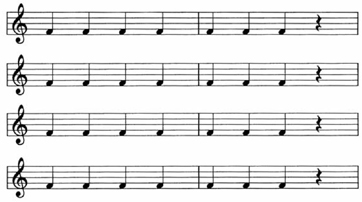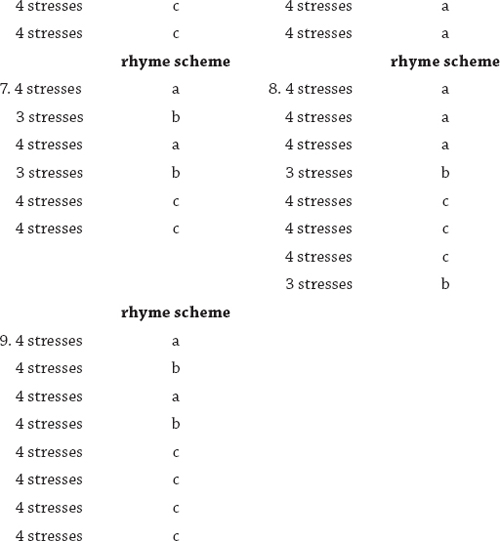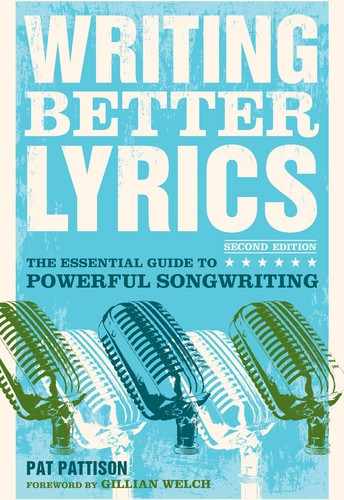CHAPTER SIXTEEN
METER:
TWO BY TWO
As we saw in chapter fourteen, common meter typically organizes music into a single eight-bar unit, running (two bars + two bars) + (two bars + two bars). The second line of common meter, comprising bars three and four, contains only three stresses, keeping the entire system moving until it is matched at line four (bars seven and eight).
When you want to organize into four-bar units rather than eight-bar units, all you have to do is match bars one and two with bars three and four. Here's the paradigm:
|
Eénie méenie míney móe |
4 stresses |
|
Cátch a tíger ón the tóe |
4 stresses |
|
If he hóllers máke him páy |
4 stresses |
|
Fífty dóllars évery dáy |
4 stresses |
The lines are four-stress balanced lines called couplets. They move differently. There's no problem stopping after line two:
|
Eénie méenie míney móe |
4 stresses |
|
Cátch a tíger ón the tóe |
4 stresses |
Not so with common meter:
|
Máry h↑d a l↑ttle l↑mb |
4 stresses |
|
Its fléece was whíte as snów |
3 stresses |
Think of line length as a traffic cop: It tells you when to stop, and when to go. Matched line lengths are stable. Unmatched lines create instability and make us move forward, looking for a place to rest. And when you rhyme matched lines, the stop sign is even stronger.
Here's a real one from A.E. Housman's “To an Athlete Dying Young”:
The tíme you wón your tówn the ráce
We cháired you thróugh the márket pláce
Mán and bóy stood chéering by
And hóme we bróught you shóulder hígh
USING COUPLETS
Couplets usually rhyme, marking stopping places for the ear. They form a lyrical and musical unit, typically four bars long. They move us forward in regular, balanced steps with four stressed notes in each two-bar section.

You can easily extend from four lines to six without getting too far off balance. Look at the first verse of “Where've You Been” by Don Henry and Jon Vezner:
Claire had all but given up
When she and Edwin fell in love
She touched his face and shook her head
In disbelief she sighed and said
In many dreams I've held you near
Now at last you're really here
The feeling is slightly unstable, since we have an odd number of couplets, yet an even number of lines, a subtle and interesting verse structure. You can use it to create a strong sense of center, yet raise expectations that something else is coming.
You can also use a couplet at the end of a section of common meter for acceleration and contrast:
Claire had all but given up
Then fell in love with Ed
She touched his face and closed her eyes
In disbelief she said
In many dreams I've held you near
Now at last you're finally here
The ending couplet creates a real sense of interest and arrival.
You can use couplets to set up an expectation of balance, then take a different route. Like this, from David Wilcox's “Eye of the Hurricane”:
|
Tank is full, switch is on |
4 stresses |
|
Night is warm, cops are gone |
4 stresses |
|
Rocket bike is all her own |
4 stresses |
|
It's called a hurricane |
3 stresses |
|
She told me once it‐s quite a ride |
4 stresses |
|
It's shaped so there's this place inside |
4 stresses |
|
Where, if you're moving you can hide |
4 stresses |
|
Safe within the rain |
3 stresses |
Neat structure! The odd fourth line stands out because we expected a four-stress rhymed couplet. Instead, we get a three-stress unrhymed line, handing us an IOU that isn't cashed in until line eight. It's a good way to create a seamless eight-line (sixteen-bar) section.
WITHOUT COUPLETS
What happens when four-stress lines aren't rhymed in couplets? Look at this section of “The End of the Innocence” by Don Henley and Bruce Hornsby:
|
Remember when the days were long |
4 stresses |
|
And rolled beneath a deep blue sky |
4 stresses |
|
Didn't have a care in the world |
4 stresses |
|
With mommy and daddy standin' by |
4 stresses |
This is a more leisurely trip, with balanced four-bar phrases that settle gently, rather than asking for forward motion. After we've seen only the first two lines,
|
Remember when the days were long |
4 stresses |
|
And rolled beneath a deep blue sky |
4 stresses |
there is no urgent push forward, as there would have been if the lines were unmatched.
|
Mary had a little lamb |
4 stresses |
|
Whose fleece was white as snow |
3 stresses |
pushes forward, while the four-stress couplets don't:
|
Mary had a little lamb |
4 stresses |
|
Whose fleece was white as deepest snow |
4 stresses |
Instead, we just roll smoothly along, in no particular hurry.
|
rhyme |
||
|
scheme |
||
|
Remember when the days were long |
x |
4 stresses |
|
And rolled beneath a deep blue sky |
a |
4 stresses |
|
Didn't have a care in the world |
x |
4 stresses |
|
With mommy and daddy standin' by |
a |
4 stresses |
When the next three lines come along in rhyme, we can feel the acceleration, a strong pressure building forward:
|
rhyme |
||
|
scheme |
||
|
But “happily ever after” fails |
b |
4 stresses |
|
And we've been poisoned by these fairy tales |
b |
4 stresses |
|
The lawyers dwell on small details |
b |
4 stresses |
|
Since daddy had to fly |
c |
3 stresses |
Seven four-stress lines in a row, and after three rhymed lines in a row, an unrhymed three-stress line! It's a huge IOU that you can actually hear being cashed in sixteen lines later, after a pre-chorus, a chorus, and the entire second verse have come in between. That's the power of the expectations these balanced lines are able to create.
It's interesting that the last line of the verse, since daddy had to fly, sounds unrhymed. It should rhyme with sky and by in lines two and four, but since the first four lines close off to form a unit, we won't hear the connection.
The next four lines move into common meter. After all the four-stress couplets in the verse, the contrast is startling:
|
rhyme |
||
|
scheme |
||
|
But I know a place where we can go |
x |
4 stresses |
|
That's still untouched by men |
d |
3 stresses |
|
We'll sit and watch the clouds roll by |
x |
4 stresses |
|
And the tall grass wave in the wind |
d |
3 stresses |
The section moves in a completely different way — in a four-line unit rather than two by two. We get a simultaneous effect of speeding up (with shorter second and fourth lines) and slowing down (less frequent rhymes). It's a great contrast to use for this transitional section (prechorus), preparing us to go back to four-stress lines:
|
rhyme |
||
|
scheme |
||
|
You can lay your head back on the ground |
a |
4 stresses |
|
And let your hair fall all around me |
a |
4 stresses |
|
Offer up your best defense |
b |
4 stresses |
|
But this is the end |
b |
2 stresses |
|
This is The End of the Innocence |
b |
4 stresses |
All the mixing and matching of four-stress couplets and common meter has led to this chorus. Here's the payoff for all the balanced lines and even numbers of bars. With a maddeningly simple move of inserting only a piece of the last line, but this is the end, everything is thrown off balance. There are now an odd number of lines in the chorus. There is an odd rhyme scheme. There is a two-stress line for the first time. And the chorus stretches beyond the eight-bar units we saw in the verse and pre-chorus into eleven bars. An effective way to showcase the title. This is The End of the Innocence.
Throwing it off balance keeps it from closing solidly; it supports the emotion of the idea — a sort of bittersweet longing that feels a little airy and suspended, matching the unstable structural perfectly. Very impressive. And all done in couplets and common meter.
EXERCISE 20
Here are a few exercises to get you moving. Write a section for each of the following models and watch it in action. Then put a few of the more unusual rhyme schemes in your toolbox for later use. Offer your listeners some nice surprises.


Pretty easy stuff, step by step. But you can build interesting structures by mixing and matching couplets and common meter. Obviously, there are more lines available in the universe than are found in these two philosophies, but they, with their combinations and variations, can take us a long way without stopping anywhere else. We'll look at more of the essential building blocks later, in chapter nineteen, “Understanding Motion.”
